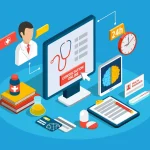
Methods Adopted To Maintain Quality In Hospital
In the current healthcare system, keeping hospitals at a high standard is important so they receive top-notch care, get the best outcomes, and retain their general well-being. This means putting in place strict quality control procedures and utilizing state-of-the-art technologies designed to produce positive results and raise the bar for medical treatment.
Here, we explore the importance of maintaining quality in hospitals, highlighting typical problems and how successful tactics improve the efficacy of healthcare.
How To Maintain Quality In Hospitals?
Maintaining quality in hospitals involves prioritizing the consistent and effective delivery of high-quality care according to established standards.
Quality control projects play a pivotal role in identifying and addressing weaknesses within healthcare delivery processes, ensuring continuous improvement. Additionally, the integration of computerized tools enhances diagnostic accuracy and streamlines workflow, further contributing to quality assurance efforts in hospitals.
Moreover, ongoing professional staff retraining ensures healthcare providers remain updated with the latest advancements, ultimately benefiting patient care. This comprehensive approach to quality control in the hospital underscores the commitment to delivering optimal patient outcomes and maintaining excellence in healthcare delivery.
Top Strategies For Maintaining Quality In Hospitals
Hospitals’ primary purpose is to deliver safe and effective care while maintaining consistently high-quality standards. To stay at the top, hospitals create strategic plans that integrate technology advancements, workforce development, quality improvement programs, and practices based on research. Here are some of the major methods adopted to maintain quality in hospitals:
1. Implementation Of Evidence-Based Practices
Hospitals use methods based on evidence-based scientific research to standardize care delivery and maintain quality standards. These practices provide consistency and efficacy in treatment approaches, which leads to better patient outcomes and contributes to the maintenance of healthcare quality.
2. Utilization Of Quality Improvement Initiatives
Using quality improvement monitoring, hospital staff can frequently identify new areas for progress and set goals to attain a certain outcome. To explore problems connected to the gaps in the structure, these studies entail collecting and analyzing data, analyzing plate locations, and putting evidence-based interventions into practice.
Hospitals’ implementation of continuous performance assessment methods and subsequent professional enhancement programs results in quality gains.
3. Adopting Latest Technology and Innovation
Technology and innovation can be seen as critical components in ensuring the quality of patient care in hospitals. Electronic health records (EHRs), patient feedback systems, clinical decision support systems, and telemedicine platforms contribute to faster workflow, improved communication across healthcare teams, and improved diagnosis accuracy. Apart from this, there are many other computer software for hospitals that can be used to maintain quality.
Hospitals can obtain optimal resource use, improve patient outcomes, and increase overall productivity with the use of technology.
Ensure continuous quality improvement with LazyMonkey’s patient feedback software, designed to streamline feedback collection and reporting.
4. Staff Training and Education
Addressing the provision of training and education to healthcare employees forms the basis for high-quality services in hospitals. A professional-developed experience by caregiver employees facing new scientific discoveries, principles, and safety measures from month to month.
Guaranteeing the availability of adequately trained personnel with the required professional skills will improve clinical efficiency and joint practice and be vital for the proper serving of patients.
Benefits Of Quality Management In Hospitals
Implementing quality management in hospitals provides numerous advantages that ultimately lead to improved patient care and organizational efficiency. Some key benefits include:
1. Improved Patient Safety
Quality management emphasizes standardized processes, protocols, and checklists that help reduce medical errors, hospital-acquired infections, and other adverse events. This increased focus on patient safety minimizes risks and ensures better outcomes.
2. Enhanced Patient satisfaction
By delivering consistent, high-quality care, hospitals with effective quality management tend to have higher patient satisfaction rates. Satisfied patients are more likely to recommend the hospital and return for future care.
3. Regulatory Compliance
Maintaining quality helps hospitals meet regulatory requirements and industry standards set by regulating authorities. Compliance helps hospitals avoid penalties and maintain eligibility for reimbursements.
4. Operational Efficiencies
Standardized processes, continuous improvement methodologies, and data-driven decision-making lead to streamlined operations, reduced waste, and optimized resource utilization within the hospital.
5. Cost Savings
By improving efficiency, reducing errors and rework, and shortening patient stays, quality management initiatives lead to substantial cost savings for the hospitals over time.
Conclusion
In the modern healthcare system, maintaining high standards in hospitals is essential for delivering exceptional care, achieving optimal patient outcomes, and ensuring overall well-being. Through the implementation of precise quality control measures, hospitals can enhance their medical treatment standards.
By focusing on evidence-based practices, quality improvement initiatives, technological advancements, and continuous staff training, hospitals can achieve significant benefits such as improved patient safety, higher satisfaction rates, regulatory compliance, operational efficiencies, and cost savings.
Frequently Asked Questions? (FAQs)
Why Is Maintaining Quality In Hospitals Important?
Maintaining quality ensures patients receive top care, improving health outcomes and patient satisfaction while reducing errors.
What Are Key Strategies For Hospital Quality Maintenance?
Strategies include evidence-based practices, quality improvement initiatives, adopting technology, and continuous staff training.
How Does Technology Help Improve Quality In Hospitals?
Technology enhances diagnostic accuracy, streamlines workflows, and improves communication, leading to better patient outcomes.
Why Is Staff Training Essential For Quality Management?
Ongoing staff training ensures healthcare providers stay updated on the latest medical advancements and safety practices.
Enhance Patient Care and NABH Compliance with LazyMonkey
LazyMonkey is your all-in-one solution for improving patient care, retaining more patients, and meeting NABH standards. Our powerful QR-based feedback tool enables you to capture real-time insights from patient feedback, discharge surveys, staff and doctor evaluations, and clinical research, while also streamlining inter-departmental communication.
Transform your healthcare facility today - reach out to us at [email protected], or request a demo here!
Elevate Your Restaurant Experience with LazyMonkey
LazyMonkey’s QR-based feedback system helps you gather real-time insights from customers, track satisfaction levels, and enhance the dining experience. Get instant feedback on your menu, service, and ambience, and make data-driven improvements to boost repeat customers and reviews.
Improve your restaurant today – reach out to us at [email protected], or request a demo here!
Empower Student Engagement and Campus Improvement with LazyMonkey
LazyMonkey offers a seamless way to gather student feedback, track satisfaction, and enhance campus life. From course evaluations to dorm feedback, our QR-based solution makes it easy to capture valuable insights and improve student retention.
Upgrade your university experience – contact us at [email protected], or request a demo here!
Streamline Feedback and Drive Performance Across Your Enterprise/Franchise with LazyMonkey
Whether you manage one or multiple locations, LazyMonkey’s QR-based feedback system helps you gather real-time employee and customer feedback. Improve operational efficiency, track satisfaction, and make data-driven decisions to enhance brand consistency and growth.
Transform your franchise today – reach out to us at [email protected], or request a demo here!
Enhance Customer Satisfaction and Service Standards in Banking with LazyMonkey
LazyMonkey empowers banks to capture real-time feedback from clients across branches. Improve customer experience, assess service quality, and ensure regulatory compliance with our QR-based solution, helping you retain clients and meet banking standards.
Elevate your bank’s customer care – contact us at [email protected], or request a demo here!
Boost Customer Engagement and Mall Satisfaction with LazyMonkey
LazyMonkey’s QR-based feedback tool enables you to collect feedback from shoppers, track satisfaction, and enhance the mall experience. Gather insights on store services, cleanliness, and entertainment to create an unmatched customer journey.














